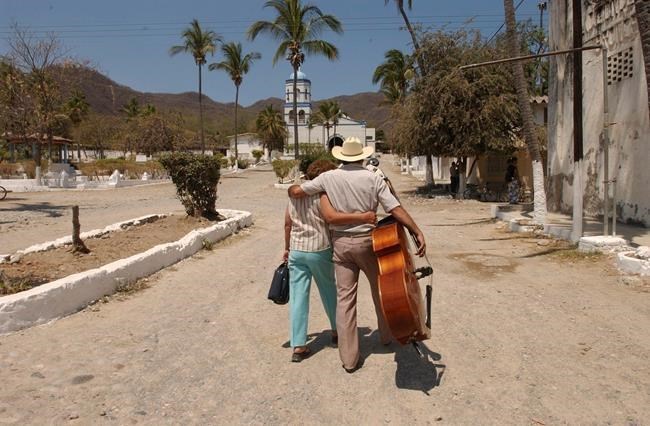
FILE - In this May 12, 2005 file photo, inmate Francisco Loera, who is serving a 10 year sentence, walks with his bass while embracing his partner Alicia Anchondo who arrived to visit him at the Islas Marias federal prison island, located 90 miles south of Mazatlan, Mexico. President Andres Manuel Lopez Obrador said on Monday, Feb. 18, 2019 that he will close the famed island penal colony and will have it converted into a cultural and environmental education center. (AP Photo/Eduardo Verdugo, File)
Republished February 18, 2019 - 7:25 PM
Original Publication Date February 18, 2019 - 8:11 AM
MEXICO CITY - Mexico will close its infamous Isla Marias prison, the last island penal colony in a hemisphere once dotted with remote island jails like the one depicted in the movie "Papillon."
President Andres Manuel Lopez Obrador said Monday that Mexico will relocate about two-thirds of the 659 remaining inmates and free about 200 others from the islands, 70 miles (110 kilometres) off the Pacific coast of Nayarit. The four islands — only one of which is inhabited — will be turned into a cultural and environmental education centre.
The prison founded in 1905 on Maria Madre passed through periods of infamous brutality. When Panama closed its Isla Coiba penal colony in 2004, Isla Marias became the last one remaining in the Americas.
Lopez Obrador said the new Islas Marias cultural centre will be named after Jose Revueltas, a novelist who was imprisoned there and wrote the novel "Walls of Water."
"It is the history of punishments, of torture, of repression for more than a century," Lopez Obrador said of the prison, which as recently as 2013 held 8,000 inmates.
Far from the bloody reputation of places like Devil's Island — the French Guiana penal colony shuttered in 1946 — toward the end the Islas Marias had harboured many lower-risk or well-behaved inmates for whom the "prison without walls" was viewed as step toward release or rehabilitation. Some prisoners were even allowed to live their families.
While the prison kept mass tourism at bay, the islands suffered severe environmental degradation from over a century of use as a penal colony, said Ramon Ojeda Mestre, who served as from 2000 to 2004 as head of the environmental recovery program for the islands.
"It protected the three uninhabited islands, but Maria Madre suffered a lot of environmental deterioration," said Ojeda Mestre.
Ojeda Mestre's battled to reforest the island with topical hardwoods, which had been largely cut down to build the penal colony and furnish it. He also battle to rid the uninhabited islands of invasive, non-native feral goats, dogs and cats.
"We lost a lot of boa constrictors, because they (inmates) would kill them to make belts out of their skins," he recalled. (That was one of the many cottage industries that sprang up: inmates also fermented fruit for home-made alcoholic beverages.)
Also at risk due to the penal colony was the yellow-headed "Tres Marias" parrot found nowhere else. "The inmates captured the parrots to sell them," he said. "Their relatives would smuggle them out clandestinely" when they came for visits and sell the birds on the mainland.
Ojeda Mestre's battle was part of an early effort to turn the penal colony into a nature reserve, but that plan fell victim in 2005 to what later became known as Mexico's War on Drugs; the government argued it needed more, not less, prison space.
In the end, the 12-hour boat rides that relatives had to endure in order to visit inmates was "cruel," Ojeda Mestre said, calling the decision to close the prison "an extraordinary piece of news that should be celebrated throughout the Americas."
Indeed, the hemisphere began turning its back on the isolated prisons decades ago.
Chile closed its Santa Maria prison island in the late 1980s, Costa Rica's Isla San Lucas penal colony closed in 1991 and Brazil's Isla Grande in 1994. Peru dramatically ended its El Fronton island prison in 1986: Gunboats blew up most of the buildings to put down a riot, killing more than 100 inmates.
Island penal colonies were used around the world starting in the 1700s as remote, escape-proof places to "rehabilitate" inmates through hard labour. Most also tried to be self-supporting and to help settle remote territories.
Mexico's federal prisons are nowhere near capacity, making closure of the island prison more palatable. The government said it costs about $150 a day to house each inmate at Isla Marias, far higher than other jails. The islands are also routinely battered by hurricanes, the last of which caused about $150 million in damage to the prison facilities.
The last other such prison in the Americas, Panama's Coiba Island penal colony, was closed in 2005 and turned into to a nature reserve. The jungle is slowly swallowing the buildings, providing a glimpse of what will happen at the Islas Marias.
"The remaining structure is slowly being reclaimed by jungle and the marine air. Its crumbling buildings and simply marked graves serve as the only memorial to Coiba's dark history," the park says on its website.
News from © The Associated Press, 2019